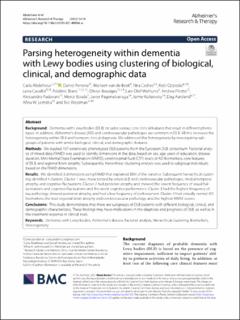| dc.contributor.author | Abdelnour, Carla | |
| dc.contributor.author | Ferreira, Daniel | |
| dc.contributor.author | van de Beek, Marleen | |
| dc.contributor.author | Cedres, Nira | |
| dc.contributor.author | Oppedal, Ketil | |
| dc.contributor.author | Cavallin, Lena | |
| dc.contributor.author | Blanc, Frédéric | |
| dc.contributor.author | Bousiges, Olivier | |
| dc.contributor.author | Wahlund, Lars-Olof | |
| dc.contributor.author | Pilotto, Andrea | |
| dc.contributor.author | Padovani, Alessandro | |
| dc.contributor.author | Boada, Mercè | |
| dc.contributor.author | Pagonabarraga, Javier | |
| dc.contributor.author | Kulisevsky, Jaime | |
| dc.contributor.author | Aarsland, Dag | |
| dc.contributor.author | Lemstra, Afina W. | |
| dc.contributor.author | Westman, Eric | |
| dc.date.accessioned | 2023-03-15T14:41:04Z | |
| dc.date.available | 2023-03-15T14:41:04Z | |
| dc.date.created | 2022-05-12T12:05:16Z | |
| dc.date.issued | 2022 | |
| dc.identifier.citation | Abdelnour, C., Ferreira, D., van de Beek, M., Cedres, N., Oppedal, K., Cavallin, L., ... & Westman, E. (2022). Parsing heterogeneity within dementia with Lewy bodies using clustering of biological, clinical, and demographic data. Alzheimer's research & therapy, 14(1), 1-13. | en_US |
| dc.identifier.issn | 1758-9193 | |
| dc.identifier.uri | https://hdl.handle.net/11250/3058557 | |
| dc.description.abstract | Background
Dementia with Lewy bodies (DLB) includes various core clinical features that result in different phenotypes. In addition, Alzheimer’s disease (AD) and cerebrovascular pathologies are common in DLB. All this increases the heterogeneity within DLB and hampers clinical diagnosis. We addressed this heterogeneity by investigating subgroups of patients with similar biological, clinical, and demographic features.
Methods
We studied 107 extensively phenotyped DLB patients from the European DLB consortium. Factorial analysis of mixed data (FAMD) was used to identify dimensions in the data, based on sex, age, years of education, disease duration, Mini-Mental State Examination (MMSE), cerebrospinal fluid (CSF) levels of AD biomarkers, core features of DLB, and regional brain atrophy. Subsequently, hierarchical clustering analysis was used to subgroup individuals based on the FAMD dimensions.
Results
We identified 3 dimensions using FAMD that explained 38% of the variance. Subsequent hierarchical clustering identified 4 clusters. Cluster 1 was characterized by amyloid-β and cerebrovascular pathologies, medial temporal atrophy, and cognitive fluctuations. Cluster 2 had posterior atrophy and showed the lowest frequency of visual hallucinations and cognitive fluctuations and the worst cognitive performance. Cluster 3 had the highest frequency of tau pathology, showed posterior atrophy, and had a low frequency of parkinsonism. Cluster 4 had virtually normal AD biomarkers, the least regional brain atrophy and cerebrovascular pathology, and the highest MMSE scores.
Conclusions
This study demonstrates that there are subgroups of DLB patients with different biological, clinical, and demographic characteristics. These findings may have implications in the diagnosis and prognosis of DLB, as well as in the treatment response in clinical trials. | en_US |
| dc.language.iso | eng | en_US |
| dc.publisher | BMC | en_US |
| dc.rights | Navngivelse 4.0 Internasjonal | * |
| dc.rights.uri | http://creativecommons.org/licenses/by/4.0/deed.no | * |
| dc.title | Parsing heterogeneity within dementia with Lewy bodies using clustering of biological, clinical, and demographic data | en_US |
| dc.type | Peer reviewed | en_US |
| dc.type | Journal article | en_US |
| dc.description.version | publishedVersion | en_US |
| dc.rights.holder | The authors | en_US |
| dc.subject.nsi | VDP::Medisinske Fag: 700 | en_US |
| dc.source.volume | 14 | en_US |
| dc.source.journal | Alzheimer's Research & Therapy | en_US |
| dc.source.issue | 1 | en_US |
| dc.identifier.doi | 10.1186/s13195-021-00946-w | |
| dc.identifier.cristin | 2023876 | |
| cristin.ispublished | true | |
| cristin.fulltext | original | |
| cristin.qualitycode | 1 | |

